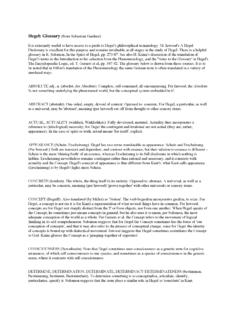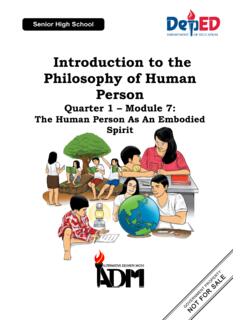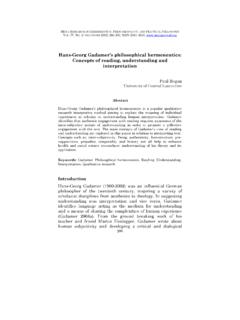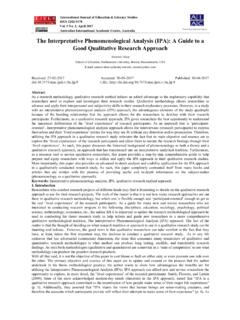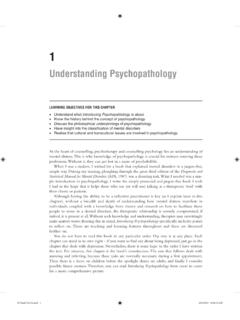Transcription of MAPS OF MEANING THE ARCHITECTURE OF BELIEF
1 MAPS OF MEANING : THE ARCHITECTURE OF BELIEF ROUTLEDGE (1999) Jordan B. Peterson, PDF Version with Figures May 2002 2 3 PREFACE: DESCENSUS AD INFEROS_____7 CHAPTER 1: MAPS OF EXPERIENCE: OBJECT AND MEANING_____15 CHAPTER 2: MAPS OF MEANING : THREE LEVELS OF ANALSIS_____28 Normal and Revolutionary Life: Two Prosaic Stories_____29 Normal Life_____31 Revolutionary Life_____35 Neuropsychological Function: The Nature of the Mind_____37 The Valence of Things_____38 Unexplored Territory: Phenomenology and Neuropsychology_____44 Exploration.
2 Phenomenology and Neuropsychology_____49 Explored Territory: Phenomenology and Neuropsychology_____59 Mythological Representation: The Constituent Elements of Experience_____80 Introduction_____81 The Enuma elish: A Comprehensive Exemplar of Narrative Categorization_____93 The Dragon of Primordial Chaos_____115 The Great Mother: Images of the Unknown, or Unexplored Territory_____124 The Divine Son: Images of the Knower, the Exploratory Process_____145 The Great Father: Images of the Known, or Explored Territory_____153 CHAPTER 3: APPRENTICESHIP AND ENCULTURATION: ADOPTION OF A SHARED MAP_____175 CHAPTER 4: THE APPEARANCE OF ANOMALY: CHALLENGE TO THE SHARED MAP_____188 Introduction: The Paradigmatic Structure of the Known_____189 Particular Forms of Anomaly.
3 The Strange, the Stranger, the Strange Idea & the Revolutionary Hero197 The Strange_____197 The Stranger_____199 The Strange Idea_____201 The Revolutionary Hero_____216 The Rise of Self-Reference, and the Permanent Contamination of Anomaly with Death_____225 CHAPTER 5: THE HOSTILE BROTHERS: ARCHETYPES OF RESPONSE TO THE UNKNOWN_____244 Introduction: The Hero and the Adversary_____244 The Adversary: Emergence, Development and Representation_____247 The Adversary in Action: Voluntary Degradation of the Map of Meaning_____256 The Adversary In Action: A Twentieth Century Allegory_____269 Heroic Adaptation.
4 Voluntary Reconstruction of the Map of Meaning_____289 The Creative Illness and the Hero_____290 The Alchemical Procedure and the Philosopher s Stone_____312 Introductory Note_____312 Part One_____312 Part Two_____316 The Material World as Archaic Locus of the Unknown _____317 Episodic Representation in Medieval Christendom_____324 The Prima Materia_____330 The King of Order_____332 The Queen of Chaos_____334 The Peregrination_____335 The Conjunction_____341 Conclusion: The Divinity of Interest_____346 Introduction_____347 The Divinity of Interest_____353 4 Figure 1: The Domain and Constituent Elements of the Known 23 Figure 2: The Metamythological Cycle of the Way 25 Figure 3: Normal Adaptation 34 Figure 4: Revolutionary Adaptation 36 Figure 5: The Ambivalent Nature of Novelty 45 Figure 6: Emergence of "Normal Novelty" in the Course of Goal-Directed Behavior 46 Figure 7: Emergence of "Revolutionary Novelty" in the Course of Goal-Directed Behavior 47 Figure 8.
5 The Motor and Sensory Units of the Brain 49 Figure 9: The Regeneration of Stability from the Domain of Chaos 54 Figure 10: The Motor Homunculus 59 Figure 11: The Twin Cerebral Hemispheres and their Functions 63 Figure 12: The Multiple Structure of Memory 67 Figure 13: Abstraction of Wisdom, and the Relationship of Such Abstraction to Memory 72 Figure 14: Conceptual Transformation of the Means/Ends Relationship from Static to Dynamic 74 Figure 15: Bounded Revolution 76 Figure 16: Nested Stories, Processes of Generation, Multiple Memory Systems 78 Figure 17: The Constituent Elements of Experience 90 Figure 18: The Positive Constituent Elements of Experience, Personified 91 Figure 19: The Birth of the World of Gods 95 Figure 20: The "Death" of Apsu, and the (Re)Emergence of Tiamat as Threat 98 Figure 21: "World" of Gods: Hierarchical Organization 101 Figure 22: The Enuma elish in Schematic Representation 104 Figure 23: The Battle between Osiris and Seth in the Domain of Order 108 Figure 24.
6 The Involuntary Descent and Disintegration of Osiris 108 Figure 25: The Birth and Return of Horus, Divine Son of Order and Chao 109 Figure 26: Voluntary Encounter with the Underworld 110 Figure 27: Ascent, and Reintegration of the Father 111 Figure 28: The Constituent Elements of Experience as Personality, Territory and Process 114 Figure 29: The Uroboros - Precosmogonic Dragon of Chaos 117 Figure 30: The Birth of the World Parents 120 Figure 31: The Constituent Elements of the World, in Dynamic Relationship 121 Figure 32: Novelty, the Great Mother, as Daughter of the Uroboros 128 Figure 33: The Spontaneous Personification of Unexplored Territory 130 Figure 34: Unexplored Territory as Destructive Mother 133 Figure 35: Unexplored Territory as Creative Mother 138 Figure 36: The "Heavenly Genealogy" of the Destructive and Creative Mothers 139 Figure 37: The Exploratory Hero as Son of the Heavenly Mother 147 Figure 38: The Metamythology of the Way, revisited 148 Figure 39: Castle, Hero, Serpent and Virgin: St.
7 George and the Dragon 150 Figure 40: The Process of Exploration and Update, as the Meta-Goal of Existence 151 Figure 41: Order, the Great Father, as Son of the Uroboros 167 Figure 42: Explored Territory as Orderly, Protective Father 168 Figure 43: Explored Territory as Tyrannical Father 171 Figure 44: The "Heavenly Genealogy" of the Tyrannical and Protective Fathers 172 Figure 45: The Exploratory Hero as Son of the Great Father 173 Figure 46: The "Death" and "Rebirth" of the Adolescent Initiate 180 Figure 47: The Paradigmatic Structure of the Known 193 Figure 48: The Known: Nested Groups and Individuals 194 Figure 49: The Fragmentary Representation of "Procedure and Custom" in Image and Word 201 Figure 50: The "Dual Death" of the Revolutionary Hero 216 Figure 51: The Crucified Redeemer as Dragon of Chaos and Transformation 221 Figure 52: The Socially Destructive and Redemptive "Journey" of the Revolutionary Hero 222 5 Figure 53: The (Voluntary) Descent of the Buddha 231 Figure 54.
8 The World-Tree as Bridge between "Heaven" and "Hell" 233 Figure 55: The World-Tree and the Constituent Elements of Experience 236 Figure 56: Genesis and Descent 241 Figure 57: The Devil as Aerial spirit and Ungodly Intellect 248 Figure 58: The Vicious Circle of the Adversary 259 Figure 59: The Constituent Elements of Existence, reprise. 265 Figure 60: The Emergence of Christ from Group Identity and Chaos 300 Figure 61: World-Tree of Death and Redemption 309 Figure 62: The Alchemical Opus as "Normal Story" 328 Figure 63: The Alchemical Opus as "Revolutionary Story" 329 Figure 64: The Wolf as prima materia, Devouring the Dead King 336 Figure 65: Dragon of Chaos as "Birthplace" of Christ and the Lapis 339 Figure 66: The Alchemical Opus as Myth of Redemption 345 Figure 67: The Restitution of [Christ] the Mystic Apple to the Tree of Knowledge 358 Figure 68.
9 The Eternal Return of the Boddhisatva 359 6I will utter things which have been kept secret from the foundation of the world. (Matthew 13:35) 7 PREFACE: DESCENSUS AD INFEROS Something we cannot see protects us from something we do not understand. The thing we cannot see is culture, in its intrapsychic or internal manifestation. The thing we do not understand is the chaos that gave rise to culture. If the structure of culture is disrupted, unwittingly, chaos returns. We will do anything anything to defend ourselves against that return.
10 The very fact that a general problem has gripped and assimilated the whole of a person is a guarantee that the speaker has really experienced it, and perhaps gained something from his sufferings. He will then reflect the problem for us in his personal life and thereby show us a truth. 1 I was raised under the protective auspices, so to speak, of the Christian Church. This does not mean that my family was explicitly religious. I attended conservative Protestant services during childhood with my mother, but she was not a dogmatic or authoritarian believer, and we never discussed religious issues at home.

